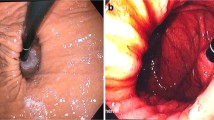Abstract
Dysphagia is a common problem and an indication for upper endoscopy. There is no data on the frequency of the different endoscopic findings and whether they change according to demographics or by single versus repeat endoscopy. To determine the prevalence of endoscopic findings in patients with dysphagia and whether findings differ in regard to age, gender, ethnicity, and repeat procedure. This was a retrospective study using a national endoscopic database (CORI). A total of 30,377 patients underwent esophagogastroduodenoscopy (EGD) for dysphagia of which 4,202 patients were repeat endoscopies. Overall frequency of endoscopic findings was determined by gender, age, ethnicity, and single vs. repeat procedures. Esophageal stricture was the most common finding followed by normal, esophagitis/ulcer (EU), Schatzki ring (SR), esophageal food impaction (EFI), and suspected malignancy. Males were more likely to undergo repeat endoscopies and more likely to have stricture, EU, EFI, and suspected malignancy (P = 0.001). Patients 60 years or older had a higher prevalence of stricture, EU, SR, and suspected malignancy (P < 0.0001). Esophageal stricture was most common in white non-Hispanic patients compared to other ethnic groups. In patients undergoing repeat EGD, stricture, SR, EFI, and suspected malignancy were more common (P < 0.0001). The prevalence of endoscopic findings differs significantly by gender, age, and repeat procedure. The most common findings in descending order were stricture, normal, EU, SR, EFI, and suspected malignancy. For patients undergoing a repeat procedure, normal and EU were less common and all other abnormal findings were significantly more common.




Similar content being viewed by others
References
Cook I, Kahrilas P. AGA technical review on management of oropharyngeal dysphagia. Gastroenterology. 1999;116:455–78.
Lindgren S, Janzon L. Prevalence of swallowing complaints and clinical findings among 50–70 year old men and women in an urban population. Dysphagia. 1991;6:187–92.
Talley NJ, Zinsmeister AR, Schleck CD, Melton LJ III. Dyspepsia and dyspepsia subgroups: a population-based study. Gastroenterology. 1992;102:1259–68.
American Speech-Language-Hearing Association. Prevalence of speech, voice and language disorders in the United States. Rockville, MD: American Speech-Language-Hearing Association; 1994.
Eslick GD, Talley NJ. Dysphagia: epidemiology, risk factors and impact on quality of life—a population-based study. Aliment Pharmacol Ther. 2008;27:971–9.
Ekberg O, Hamdy S, Wojsard V, Hannig-Wuttge A, Ortega P. Social and psychological burden of dysphagia: its impact on diagnosis and treatment. Dysphagia. 2002;17:139–46.
Lind CD. Dysphagia: evaluation and treatment. Gastroenterol Clin N Am. 2003;32:553–75.
Wilkins T, Gillies RA, Thomas AM, Wagner PG. The prevalence of dysphagia in primary care patients: a HamesNet Research Network Study. J Am Board Fam Med. 2007;20:144–50.
Richter JE. Practical approach to the diagnosis and treatment of esophageal dysphagia. Compr Ther. 1998;24:446–53.
Locke GR III, Talley NJ, Fett SL, Zinsmeister AR, Melton LJ III. Prevalence and clinical spectrum of gastroesophageal reflux: a population-based study in Olmstead County, Minnesota. Gastroenterology. 1997;112:1448–56.
Locke GR III, Talley NJ, Fett SL, Zinsmeister AR, Melton LJ III. Risk factors associated with symptoms of gastroesophageal reflux. Am J Med. 1999;106:642–9.
Lieberman DA, DeGarmo PL, Fleischer DE, Eisen GM, Helfand M. Patterns of endoscopy use in the United States. Gastroenterology. 2000;118:619–24.
Marks RD, Richter JE. Peptic strictures of the esophagus. Am J Gastroenterol. 1993;88:1160–73.
Kovalak M, Peterson KA, Thomas KL, et al. Eosinophilic esophagitis and gastroesophageal reflux: independent or interactive relationship? Gastroenterology. 2008;134:A290.
Attwood SE, Lamb CA. Eosinophilic oesophagitis and other non-reflux inflammatory conditions of the oesophagus: diagnostic imaging and management. Best Pract Res Clin Gastroenterol. 2008;22:639–60.
Baxi S, Gupta SK, Swigonski N, et al. Clinical presentation of patients with eosinophilic inflammation of the esophagus. Gastrointest Endosc. 2006;64:473–8.
Mackenzie SH, Go M, Chadwick B, Thomas KL, Fang JC, Kuwada S, Lamphier S, Hilden K, Peterson KA. Eosinophilic oesophagitis in patients presenting with dysphagia—a prospective analysis. Aliment Pharmacol Ther. 2008;28:1140–6.
Westbrook JL. Trends in the utilization of diagnostic upper GI endoscopy in New South Wales, Australia, 1988 to 1998. Gastrointest Endosc. 2002;55:847–53.
Galvez C, Garrigues V, Ortiz V, Ponce M, Nos P, Ponce J. Healthcare seeking for constipation: a population-based survey in the Mediterranean area of Spain. Aliment Pharmacol Ther. 2006;24:421–8.
Parslow R, Jorm A, Christensen H, Jacomb PA, Rodgers B. Gender differences in factors affecting use of health services: an analysis of a community study of middle-aged and older Australians. Soc Sci Med. 2004;59:2121–9.
Byrne KR, Panagiotakis PH, Hilden K, Thomas KL, Peterson KA, Fang JC. Retrospective analysis of esophageal food impaction: differences in etiology by age and gender. Dig Dis Sci. 2006;52:717–21.
Wu JC. Gastroesophageal reflux disease: an Asian perspective. J Gastroenterol Hepatol. 2008;23:1785–93.
Author information
Authors and Affiliations
Corresponding author
Rights and permissions
About this article
Cite this article
Krishnamurthy, C., Hilden, K., Peterson, K.A. et al. Endoscopic Findings in Patients Presenting with Dysphagia: Analysis of a National Endoscopy Database. Dysphagia 27, 101–105 (2012). https://doi.org/10.1007/s00455-011-9346-0
Received:
Accepted:
Published:
Issue Date:
DOI: https://doi.org/10.1007/s00455-011-9346-0



